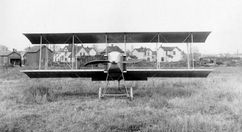Some final photo’s from Keith:

Last two. Attempt to show Orville “flying”. Last photo is from pre-detailing to show rib and spar details. Done with a light brown Prismacolor marker available from craft stores like Michael’s. Put on the bare foam before over-painting with the High-Heat Almond paint. Gives a nice muted look as if real ribs and spars are underneath fabric covering. Looks great in the air.
…………
Also thought I took a few shots of the launch dolly, but I guess not. It works well, both flights off the dolly. Will be sure to take some shots if the weather holds this weekend.
Dave, this has been a fun project to do, it let me do a lot of “adaptive” engineering that I so enjoy.
Thanks!
Keith

Love the Faux ribs and spars idea. It adds an extra dimension of scale detail and sounds really simple. I am thinking the next one I do will use your method. I might do the carbon rods and trailing edge as well??? Might be too much of a good thing if I did.
Dave















